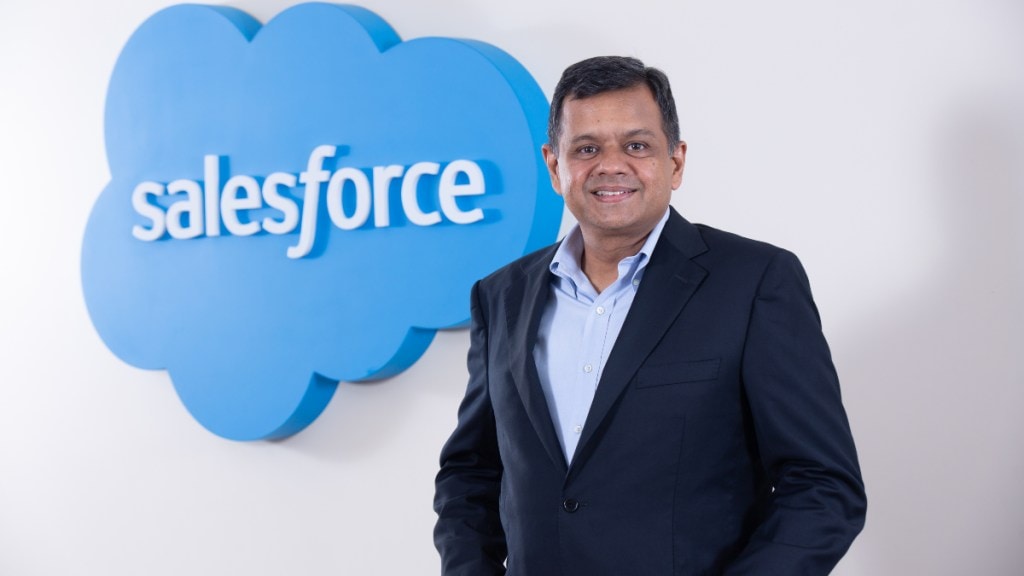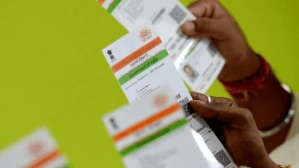For Salesforce, the modern-day world is a combination of four things: CRM, data, AI, and trust. The company piloted a lot of strides in customer relationship management when it was founded, some 24 years back (along with SaaS and cloud) and did it so well, everybody knows Salesforce as “the CRM company” today. With AI, it wants to do the same thing, in fact, it wants to champion the cause and by extension, help its customers stay ahead of the curve. It’s all connected.
The numbers seem to suggest, it’s winning. Senior company executives say compared to peers like Microsoft, Salesforce has accomplished a lot more in a much shorter span of time and so, the aim —now— is to be the “fastest to 50 billion [in revenue].” The company may have its roots in San Francisco, California, but its India story is starting to get a lot more interesting and while you may not have considered India as very tech-savvy in the past, in the present day and into the future, it is cruising. No wonder, Salesforce is looking at India as a big opportunity both in terms of talent and growth.
Speaking exclusively to FE.com’s Saurabh Singh, Arun Kumar Parameswaran, Senior Vice President & Managing Director, Salesforce India, takes us through the journey on the sidelines of the launch of the company’s latest State of Data and Analytics industry report. Excerpts.
Salesforce in India – what is the story so far?
Arun: In India, we’ve quadrupled in size in the last four years from 2,500 to 10,000. We have centres of excellence in Hyderabad. We do a lot of cutting-edge engineering development work for our customers. We see a huge growth story in India. I think there’s a generational opportunity. Honestly, in the last 30 years, I haven’t seen a demand pipe that is this robust, and that cuts across all industries, all segments, and all customer sizes. I’ve seen secular growth trends in the past, but they were specific to certain industries, like when you saw the whole wave around 4G happening, it was predominantly a telco wave. Then there were waves around financial services, but we’ve never seen anything that is so massive in terms of the breadth of demand, if you will. And I think that the country is also uniquely positioned with a lot of the macroeconomic environmental factors in our favour. It almost feels like there’s the rest of the world and there’s India, a public digital infrastructure stack that is second to none today. In fact, I think we’re leading the world in terms of what we’ve done building that digital infrastructure to scale. And that’s helping every company whether you’re a 10-man organisation, or a 10,000-man organisation, aspire to be digital.
Salesforce in India – where do you go from here?
Arun: We are the largest Salesforce entity outside the US. The beauty is that Salesforce is looking at India, not just from one dimension, but multiple dimensions. One dimension is the talent pool. The second dimension is the market itself. If you think about the different parts of the world, the macroeconomic picture is so dire when you look at it and then [when] you look at India, it feels like you’re in two different universes altogether. India has a very strong macroeconomic foundation and hopefully it’s our decade. From a company perspective, there’s a very clear view that we should be front and centre [here]. If you [can] solve problems for India, that pretty much works everywhere in the world. That’s the other incentive for the company to continue to innovate for India, or Bharat, which is again turning out to be an interesting, almost secular trend by itself. That then becomes a complete pivot into the rest of the world, if you will.
It’s always encouraging to get this kind of view from leaders like yourself. It’s fantastic how far India has come and how well Salesforce is doing. Do you want to take us through the report now. We can’t help but point out, it’s coming at an interesting moment in time.
Arun: You’re right. Our latest State of Data and Analytics report comes at a time where it couldn’t be more relevant because at the end of the day, data powers everything from a machine learning and an AI perspective. And trusted data is probably the biggest challenge that every C-suite executive is grappling with. We’ve surveyed over 10,000 folks in the line of analytics, IT, and business leaders from 18 countries. We had about 300 odd people from India who participated in this. We found that there’s an absolute gold rush for making sure that people have their ducks lined up in a row in this space because more than anything, they are worried about what they’re going to miss out on. More than 92 percent of the leaders believe that advancements in AI, specifically generative AI, make data management a much higher priority than where it was before. More than 75 percent are worried about how competition is going to have a leg-up on them, if they don’t have the initiatives to drive the insights from this data with AI. A lot of questions are coming up on security and trust as well. The other big piece is that generative AI is cool in a lot of ways, but it can also provide a lot of inaccurate information. And so, data accuracy, how do you cut out the noise, how do you remove bias, a lot of these things are top of the mind, as people start putting this to meaningful use that is much beyond writing poems and creating marketing campaigns. The moment you want to start trusting AI to be as autonomous as you think it can be, now, you have to worry about ten other pieces. I also think that governance is top of mind.
What is your position on AI regulation as a company?
Arun: We’re one of the top five software companies in the world and so, we get invited to a lot of conversation in this area. In fact, I know that our CEO Marc Benioff and a few others were invited to the White House when they had a closed-door conversation around AI, and what’s happening in the larger domain. We participated in a similar one in the UK. And so, we’re part of a lot of these conversations around ethical use of AI, in fact, we have an executive whose role is just to make sure that as we embed AI into the core of everything that we do, we are acutely focused on also making sure that we’re not crossing lines that we should not. I think it’s still very early days, in terms of where this is heading from a regulation perspective.
People and companies are rushing to deploy and use AI, a subject that’s still new and evolving— and prone to risk. What is Salesforce doing to minimise that risk?
Arun: We’re not saying AI just for AI’s sake. We’re saying, think about AI in combination with data and trust, and more importantly, customer relationship management (CRM), because at the end of the day, the heart of all your customer data sits in your CRM platform. Our view is that the best answers you’re going to get from AI, generative or predictive, are going to come from a combination of data that you trust the most, which is your customer data, which we as a SaaS vendor, have an obligation and a commitment to make sure we take care of. It doesn’t matter whether you’re a Mayura Bakery in Bangalore, or you’re the National Security Agency. Both these customers get the same level of security, trust, and enforceability from a Salesforce platform perspective. Today, we make probably two trillion predictions per day from a predictive AI perspective on our Einstein platform at Salesforce. When we take you on that journey, it will include multiple things including your own large language model or it could be a public LLM that you’re using, the way we work with that is we don’t keep copies of your data. We will only look for veracity of the data and the accuracy of the information we’re providing. Every customer in the world has access to the same capabilities across the board. It’s a huge differentiator for us. And particularly in the world that we come in, where you have people who are sitting on versions that are five generations behind, our promise is we will keep you current, and we’ll keep you where you need to be.
Your views on India’s AI-readiness, adoption, opportunities, and challenges?
Arun: Because of India’s inherent scale, we will find unique use cases and solutions that the world will probably not see or not want. That will propel us to the top of the chart. A lot of the demographics in India are crying for help on automation and AI is going to solve a lot of problems that otherwise we would have no way of solving. So, in some ways, I would almost say that our demographics are going to force adoption faster. What we don’t know is at our scale, how would the pricing economics work. I think that’s the piece that needs to be seen. Right now, if you look at all the use cases, a lot of it is in customer service, a lot of it is around content, how can we make things autonomous, etc. If you truly start trying to solve some of India’s problems at scale, that’s going to put a lot of stress on the resources. The cost of being able to deliver that is what we need to see as we evolve into those large-scale solutions that will solve large problems for the society here in India. Then we’ll have to see how economically viable it becomes for us to do it. It’s still early. But I foundationally believe that, like a lot of the leapfrogs that we’ve seen in technology over the last 20 years, India will leapfrog in a number of ways because of this AI growth curve that we’re seeing.
I don’t know the exact numbers, but India probably already has more users on DigiYatra, than CLEAR has had in the US over the last 10 years. I use CLEAR because I travel a lot to the US and it makes my life so much simpler at security checkpoint, but I’ve been paying USD 150 for that service. And I am thinking about what we’ve developed with DigiYatra, here in India. You can imagine that, in less than 12 months, if we’ve done more at essentially the cheapest cost possible to make this a free public digital infrastructure, here’s a classical example of where we bought AI to solve a problem at large scale that India represents. It’s not like we are saying that at some point we’re going to start charging for this either. It looks like it’s going to be a free service, primarily because we want to solve the congestion problem in airports and enhance customer experiences. We can see how AI is helping to solve large-scale problems, that otherwise, we had no other way of solving other than throwing more bodies at the problem, which can become a huge challenge at some point. DigiYatra for me is AI at work, every day.
What is the talent pool like in India right now in terms of people who are educated and capable in this space? More importantly, are you hiring? [At a time when Big Tech layoffs are becoming increasingly commonplace, we believe that’s a pertinent question.]
Arun: One of the good things that’s happened in India over the last five years is the number of data scientists, data analysts and people who can work on data models has absolutely gone through the roof. So, the foundation from a data perspective is there. If you were to think about innovation in generative AI, core large language models, a lot of that is still predominantly, Silicon Valley, West Coast [between Silicon Valley and Seattle] that probably comprises 80 percent of the innovation that’s happening today. But I think India is catching up fast and furious. We’re hiring across the board with a very clear view that every platform of Salesforce will have these capabilities embedded in it. When mobile became the latest fad, 12-14 years back, we said, we’ll make every platform fully mobile capable. When we got into predictive AI, 5-6 years back, we said, okay, Einstein is going to be embedded in everything we build, and therefore, everybody who comes on board should have these capabilities. And you’ll see that we will continue to hire in this space across a multitude of capabilities. In terms of where that talent is, I’d probably say in early stages, but again, you know how this country works, people spot a gold rush and then everyone will be heading in that direction. So, in a couple of years’ time, I think we will start seeing meaningful contributions and innovations coming out of India.
Conversely, what is your take on concerns that AI will take away jobs?
Arun: Every technology shift that’s come in the last 30 years, has come with the first worry that it’s going to take away jobs. If you look at what’s happened subsequently, it’s not just not taken away jobs, if anything, it has spurred an entire generation of new jobs. What you can expect is a little bit of volatility in the short and medium term. Automation has always gone after low-value repeatable jobs that can be replaced. What AI is threatening to do is exactly that, which is, if you’re in a space where you’re doing something that’s of relatively low value that the system can accomplish, you should expect that it is going to be taken over. But it doesn’t mean that there is no role for those people. There is still going to be a whole bunch of jobs that will be created for managing those platforms. Yes, if you’re in an industry where you’re doing certain things that can be automated at scale, then there is going to be disruption. But there are also going to be new roles and new jobs that are going to be created over the course of the next 3-5 years. If you look at the stages of AI, today, it’s predominantly a user intervention driven AI model, and the future being autonomous general insurance at some point, which people are saying anywhere between 2027-2030. That’s a very long road to getting to a point where you’re going to have Autonomous General Intelligence (AGI) come into play in the mainstream. In that process, we will see roles and jobs evolve, new capabilities, and more enablement for people to take up some of these things and move away from what they know is going to get disrupted.
And what about concerns of AI becoming larger than life and taking over humanity— from reel to real?
Arun: Technology has been and will continue to remain a force for good. And I think the benefits far outweigh the downside risks of how technology can be used. But companies need to take a step back on behalf of their customers and have conversations around security, trust, the ethical use of AI, and put guardrails to make sure that this technology [remains] a force for good. That is why a lot of companies, like Salesforce, are taking very measured, but very agile steps to make sure that our customers benefit from this revolution but are also secure in making decisions. You can’t underscore the threat, but I would want to point backwards to history and say this is not the first time we’ve seen a technology that has the potential not just to be a force for good, but also to bring unintended consequences. We’ve always found a way to make sure that it stays on the right side of that line. There have been guardrails around how technology has evolved and deployed in the past, and there’s no reason to believe that we can’t do the same with AI. We’re in the very early stages of a hype curve, but the only difference between this hype curve and the rest is that this can get past the chasm of uncertainty or where people don’t get the benefits, because the benefits are going to be obvious in this case. We will see some very striking benefits for businesses and therefore it will quickly cross the chasm and go into a quick adoption curve. This technology revolution is very different from what we’ve seen in the past, and it’s going to come at a cost that is going to be very affordable, at least from what we can see right now.
How do you see (and deal with) competition, which is frankly starting to get tighter in this space?
Arun: I go back to the famous Intel CEO [Andy Grove], quote, “Paranoid, alone survive”. We must be paranoid, not just to survive, but to thrive. For a company of our size, complexity, and size of customer base, [if you] look at our growth rates, and look at the pace at which we are innovating, I think that’s truly impressive. But the reason we are there is because we’re constantly paranoid about the fact that if we don’t innovate, we won’t grow. If we won’t grow, we can’t invest, which means we can’t innovate. It’s a vicious cycle. And so, we’re constantly looking at everybody around us and saying, are we innovating ahead of competition? Secondly, as companies grow bigger, the inevitable issues of how easy you are to do business with comes up and it’s something that we’re very acutely focused on inside the company in terms of how we engage with customers, both internally and externally. There are multiple lenses with which we look at competition. At the end of the day, competition is what keeps you alive, keeps you on your toes, and it’s required. The opportunity is so large that there is enough for everybody here.
Follow FE Tech Bytes on Twitter, Instagram, LinkedIn, Facebook.









